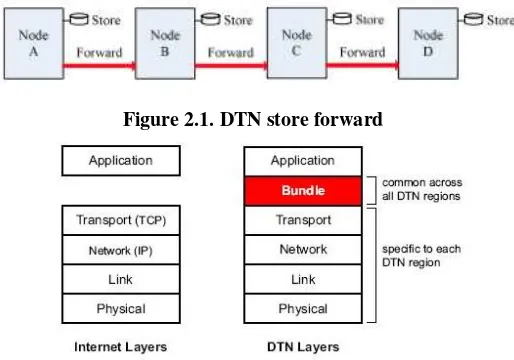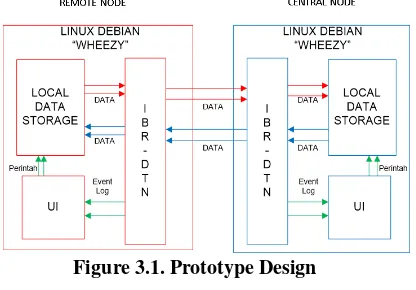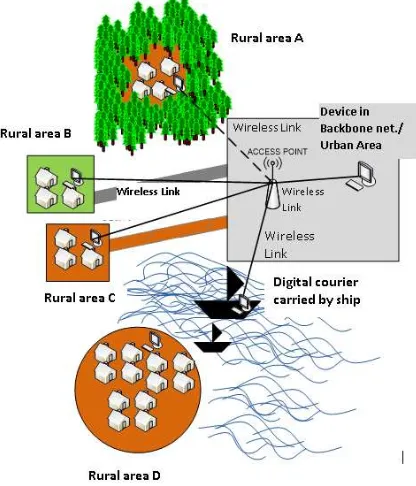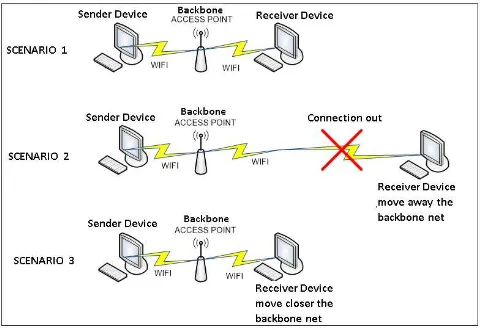Information and Data Distribution System for Rural
Areas of Indonesia
Kasyful Amron1, Achmad Basuki2, Eko Sakti P3, Widhi Yahya4
1,2,3,4Faculty of Computer Science, University of Brawijaya, Indonesia
1[email protected], 2[email protected], 3[email protected], 4[email protected]
Received 21 February 2016; received in revised form 18 March 2016; accepted 25 March 2016
Abstract. Internet becomes critical infrastructure in the distribution of information. The information is used for decision making and ensure the success of human activities. However, the distribution of information in rural Indonesia is inconvenient, because the digital communication infrastructure
(internet) doesn’t cover all areas in Indonesia. This problem causes the digital
divide in Indonesia. This study proposes communications infrastructure and data transfer mechanism or media sharing that can be applied to a variety of rural areas conditions in Indonesia, which has limited communications infrastructure. The approach is to build low power digital carrier devices in the form of minicomputer and utilize Delay or Disruptions Tolerant Network (DTN) architecture. Testing results in the digital carrier node show that the data is successfully delivered.
Keywords: Rural Area, Mini-PC, Delay Tolerant Network
1
Introduction
Information and data are key materials for decision support in every human activity. However, the distribution of information in rural areas is inconvenient, because of has limited digital communication infrastructure (internet). The Markplus Insight Data [1] shows that the distribution of internet access in Indonesia is uneven. Most access only from Java and Sumatra Island. This inequality is due to the development of computer network infrastructure precedence in densely populated areas and the high cost of development cable infrastructure on the archipelago.
The idea of this research is basically providing solutions in the form of the development of a flexible system that can be used to distribute information to a variety of rural areas conditions in Indonesia which has limited communications infrastructure, or even none at all. This system was built by utilizing minicomputers and IP-USB as an alternative medium of data exchange between the countryside to the city, where the mini computer adapt to the limited rural environment. These minicomputers can be referred to a digital carrier. The minicomputers can communicate with the network backbone using Delay Tolerant Network (DTN)’s bundle protocol that works regardless of delays.
2 Theoretical aspects
A. Delay or Disrupted Tolerant Network
Disrupted or Delay Tolerant Network is an end-to-end network architecture that provides communications services in extreme environments which has a large amount of delays or doesn’t provided by persistent of link communications [4]. In DTN architecture introduce the bundle protocol.This protocol use store and forward mechanism, which is analogous to the concept of the postman. Messages (data) collected on a medium / point(transit post office), then the data carried by the carrier (carrier) to the destination address.
Figure 2.1. DTN store forward
Figure 2.2. Bundle layer
The DTN nodes have a storage media such as hard drives, to hold messages or data before it is sent or transferred to other devices (toward the destination). In This storage media, data can be stored at an unspecified time. The DTN architecture with store and forward message switching is an overlay protocol layer called bundle layer, Figure 2.2 [2,4,5,6].
B. Mini PC
video-audio output, Network interface card and storage media using the SD card. Raspberry architecture is shown in the Figure 2.3. The raspberry pi is referred to minicomputer, on the characteristics and components similar with modern personal computers, but the raspberry pi only requires 300 mA to operate [7].
C. USB-IP
USB-IP concept invented by Takahiro Hirofumi. The basic idea is part of pervasive computing which computing occurs everywhere. USB-ISP allow accessing USB storage via a computer network without knowing where the USB is connected [8]. This method is to provide an IP address for each USB storadge, separate from the computer where the usb connected.
Figure 2.3 Raspberry pi 1 architecture[7]
3 Technical Aspects
A. why using DTN?
Delay / Disruption Tolerant Networks (DTN) is a computer network architecture that is designed for extreme areas which has not any persistent link between the source and destination, or has a large amount of delay. IP protocol basically can not be used to facilitate the communication process in that region[6]. Having such similar characteristic problems, the researchers propose DTN implementation as a digital carrier of computer network architecture in Indonesian rural areas.
B. Technological Prerequisite
The devices and technologies adapted to environmental conditions in rural Indonesia. Such conditions may vary from one region to another. But in this study were taken common conditions such as limited power source and internet network infrastructure. To deal with this problem, designed devices use the Mini PC (Raspberry type B) equipped with communication devices 802.11 (b / g / n). Raspberry type B has a power consumption of ≈ 3,5 watt [7] which is suitable for a limited power resources area. It also has high mobility because its small dimension.
C. Framework
1) Application:
board raspberry to facilitate the sending large files and as storage on the IBR-DTN.
2) Network modeling
Simulations conducted in a lab that resembles the condition of rural Indonesia. The raspberry devices placed at two different places to represent rural and urban areas. The raspberry node in the rural areas called a remote node, and in the urban areas as the central node. A standard data format is defined for ease of transmission and reception of data between devices.
Figure 3.1 and figure 3.2, shows a prototype node of the system, and the method of sending and receiving.
Figure 3.1. Prototype Design
Figure 3.2. Prototype Simulation
Each rural area has a different environment, so that the implementation of infrastructure and systems is also different for each rural area.
The scenarios are shown in Figure 3.3, there are various conditions described below:
1. Rural area A, rural communications infrastructure from location A to the backbone network. The condition of the power supply in the location A drop out frequently with time estimates that can be determined. In these conditions, the proposed system should be able to preserve the information if the network drop out suddenly or power failure occurred.
3. Rural area D, location of D area is far from the backbone network, and there is no persistent wireless communication link toward the backbone network. Therefore, in this area needs help digital carrier to convey the information from the rural area to the backbone network located in urban area, vice versa. The digital carrier in the form of raspberry device will be brought by people from rural areas toward the backbone network at an uncertain time. In this case the IP protocol cannot be used. By using the bundle protocol, the information will be stored on disk rather than dropped, if there is no connection available. This method makes the information can be sent from the rural toward the urban, vice versa.
Figure 3.3. Scheme on the site plan
4 Testing
4.1 Testing scenarios
From case studies shown in Figure 3.3, modeling and testing communication scenarios are conducted.
Scenario 2, the receiving device is taken away from the backbone network so that the connection is lost and delayed delivery of files. Files that are being sent will remain stored on the sending device and wait for a receiver.
Scenario 3 In scenario 3, the receiving device is brought back to the backbone network which is connected to the sending device. The delayed file exchanges in the scenario 2 will be resumed automatically. The receiving device will store the files in preconfigured folders.
In Figure 4.2 shows, the sender device (raspberry pi) knows that there is a receiver device (raspidesa) are connected to the same network at minute 13:09. In accordance with the first scenario, in Figure 4.2, the sending device sends a file addressed to the receive device, with inserted the file into the delivery folder “asd” at 18:41 minutes, then the files stored in a storage bundle at 18:46. After learning that the file is in the first queue, the file is sent to the receiver device immediately at 18:47.
Figure 4.2 Sequence derived from Log event on raspberry pi
In Figure 4.2 explains that the sending files to raspberry pi (the receiver device) are interrupted at 18:54, in accordance with the second scenario. When the bundle protocol knows that the connection to the receiver device is down, then the delivery of file is canceled and the file will be saved to a queue in the bundle storage with a certain lifetime. After 18 minutes, the connection to the receiver device are re-connected at minute 36:22, according to the third scenario in the Figure 4.1, the protocol bundle will be automatically re-transmit the file that was canceled due to the broken connection. At minute 36:55, mentioned that the file has reached the receiver device, and the bundle that is still in storage bundle, will be removed immediately.
Figure 4.3, shows that large file delivery depends on the size of RAM on Raspberry Pi destination. If the RAM is used in the infrastructure reaches 2GB, then the shipment could reach 2 GB of file.
5 Conclusion
The proposed infrastructure enabled to exchange information on the limited connectivity (rural to urban areas).
By utilizing digital carriers, delivery of information in areas that do not have a persistent link can be done. In this research proposed digital carrier in the form of raspberry pi equipped with 802.11 wireless communication device. The Bundle protocol (DTN) is used to enable store and forward mechanism. By using this mechanism, when connection out happened, the file that is being sent won't be dropped, but it will be stored in raspberry storage and wait for a new connection from receiver established.
6 Future Works
References
[1].Markplus Insight, “Penetrasi pengguna internet di
Indonesia”,http://www.markplusinsight.com/, access on 20 Mei 2015.
[2].Husni E, “Rural Internet Service System based on Delay Tolerant Network (DTN)
Using Train System”, International Conference on Electrical Engineering and Informatics, 2001.
[3]. B.Dojohn Loyd, D.Sivakumar, “A Case Study on VoIP over WMN Based
Architecture for Future e-Governance of Indian Rural Areas”
[4].Kevin Fall, “DTN: An Architectural Retrospective”, IEEE Journal on
Communications, 2008.
[5]. RFC 4838, “Delay-Tolerant Networking Architecture”, 2007.
[6].Kevin Fall, “A Delay-Tolerant Network Architecture for Challenged Internets”, 2003.
[7]. Raspberry Pi, https://www.raspberrypi.org/documentation/hardware/raspberrypi/,
access on Sept 2016.

![Figure 2.3 Raspberry pi 1 architecture[7]](https://thumb-ap.123doks.com/thumbv2/123dok/1589234.1549235/3.595.212.395.286.421/figure-raspberry-pi-architecture.webp)



